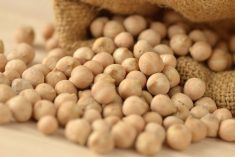MarketsFarm — Farmers in the United States will grow more lentils and peas in 2022, although chickpea area may be down, according to early estimates ahead of spring seeding.
Total pea area in the country is forecast at 1.088 million acres, which would be up 11 per cent from 2021, according to the U.S. Department of Agriculture’s prospective plantings report, released March 31. Lentil area was also forecast to be up 11 per cent on the year, at 788,000 acres.
However, early indications point to an 18 per cent reduction in chickpea area, at 303,600 acres.
Read Also

Seeds Canada announces Dan Wright as new CEO
Seeds Canada has announced Dan Wright as its new chief executive officer.
“I think the USDA numbers were fairly accurate,” said Tim McGreevy, CEO of the USA Dry Pea and Lentil Council in Moscow, Idaho. While he acknowledged a lot could happen in the next month, the official estimates were generally in line with what his organization was hearing from producers, with seed and inputs already bought for the most part.
“Lentil prices are just as good as chickpea prices, and the seed cost is about half,” said McGreevy.
High fertilizer prices were likely behind some of the increased interest in seeding peas and lentils, as the two crops don’t need extra nitrogen fertilizer. McGreevy said forward contracting prices were also generally favourable.
“Just about anything you put in the ground this year will probably make some money, but it doesn’t make any difference if you don’t get any rain,” McGreevy added, noting many of the key pulse growing regions of the western Plains were still very dry.
“We don’t need another drought,” said McGreevy, adding that “if we don’t get some timely rains it could be repeat of what we had last year.”
The ongoing conflict in Ukraine has yet to have a direct impact on the North American pulse market, as it has on wheat and oilseeds, but McGreevy said the region is also a major player in the world pea market.
Russia and Ukraine account for about a quarter of the peas in the world and have been increasing their chickpea and lentil areas recently.
As the Black Sea region is a major supplier of pulses to Europe, Africa and the Indian subcontinent, “the geopolitical shifts of where product could move this year will be interesting to watch,” McGreevy said.
— Phil Franz-Warkentin reports for MarketsFarm from Winnipeg.















